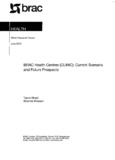BRAC Health Centres (CLINIC): current scenario and future prospects
Citation
Shatil, T., & Hossain, S. (2013, June). BRAG Health Centres (CLINIC): current scenario and future prospects. Research Reports (2013): Health Studies, Vol - XLV, 54–87.Abstract
OBJECTIVE
This study was conducted to understand the current state of affairs in the upgraded BRAC
Health Centres (now BRAC clinics) with in terms of infrastructure, operation, access, utilization
of services and client satisfaction.
METHODS
A qualitative research was carried out in four BRAC clinics that have been selected out of the
thirteen clinics that are currently in operation. Inventory, observation, exit-interviews, lOis (Indepth
Interview), FGDs (Focus group Discussion) and informal discussions were used for
collecting relevant information.
FINDINGS
All clinics were established in rented, multi-storied buildings that have been built for residential
purposes. Therefore, they posed a problem in delivering health services. BRAC clinics provided
maternal, neonatal and child healthcare that included services for common illnesses like fever,
diarrhoea, TB and malaria, at a comparatively lower cost. Interestingly, the clinics were not
oriented towards providing emergency care services (e.g. for road traffic accidents, for
drowning, poisoning, first aid etc.) Routine diagnostic tests were available in the clinics.
Prescribed medicine was mostly available in the clinic pharmacy at a nominal mark-up price.
Waiting time for patients was also within reasonable limits. The doctors and staff were found to
be modest and professional. BRAC HNPP's community health workers were found to play an
important role in referring patients from the community to the clinics. Shortage of health
professionals was a problem in all the clinics.
Most of the patients were satisfied with the services. However, the common perception of
the community was that the clinics were only for poor, pregnant women; that the clinic was
mainly a maternal and child healthcare centre. Most of the community members did not know
about the range of services provided at the clinics. The community members related the
goodwill of BRAC to the BRAC clinics and hence perceived its services to be of good quality.
CONCLUSION
The study indicates that BRAC clinics are working in the community to meet the health
challenges of community members. However, several barriers do exit. These include lack of
community awareness regarding the activities and the range of services provided, shortage of
skilled health professionals for the delivery of such services and poor infrastructure. However,
clients were satisfied with the services and BRAC's goodwill has played a determinate role in /
shaping the clinics' image in the community.

